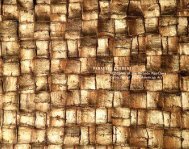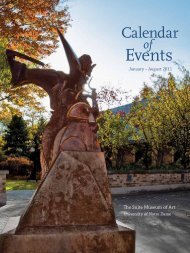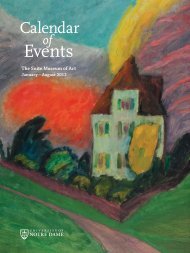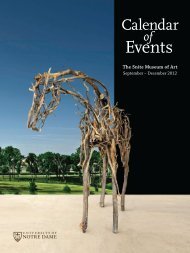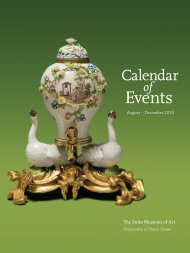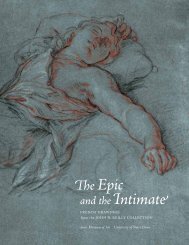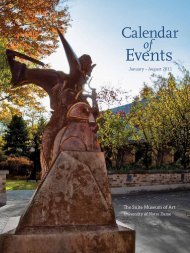HISTORY INTO ART AND ANTHROPOLOGY - Snite Museum of Art ...
HISTORY INTO ART AND ANTHROPOLOGY - Snite Museum of Art ...
HISTORY INTO ART AND ANTHROPOLOGY - Snite Museum of Art ...
You also want an ePaper? Increase the reach of your titles
YUMPU automatically turns print PDFs into web optimized ePapers that Google loves.
If possessing Western artifacts helped authenticate Lindesmith’s Western experience<br />
and legitimize the American aspect <strong>of</strong> his identity, then removing Indian<br />
burial remains helped confirm his racial identity. In attempting to justify why he<br />
donated Indian remains he had collected to the Catholic University <strong>of</strong> America in<br />
Washington, D.C., he wrote: “My chief intention for sending those bones . . . was<br />
that in the future skilled anatomists might examine them and see any difference<br />
between the Indian and white man’s bones.” 30 By taking and then donating human<br />
remains in the name <strong>of</strong> science, he apparently believed he was advancing legitimate<br />
efforts to evaluate racial differences, thus encouraging non-Indians to distinguish<br />
themselves positively in opposition to indigenous peoples.<br />
Fig. 9<br />
Rosary made with rawhide, beads, and animal toe bones, ca 1885; AA1999.049.003; SMA, UND<br />
Lindesmith’s embrace <strong>of</strong> popular beliefs about the character <strong>of</strong> Native Americans<br />
and his attempts to legitimize a national and racial identity only partly explain his<br />
taking <strong>of</strong> burial remains. A discordance inherent in these justifications must be<br />
noted: How could Lindesmith carry out his duties as a Catholic priest, on the one<br />
hand, and desecrate Indian graves on the other? It is important to point out that<br />
his theology and acts <strong>of</strong> misappropriation were not always contradictory, given that<br />
he collected both Christian and non-Christian remains. However without question,<br />
he viewed Indians as non-Christians and thus had no scruples about taking their<br />
remains. There was, however, a line he refused to cross, which reflects how his<br />
theological views sometimes influenced his collecting decisions.<br />
In his cataloguing notes, Lindesmith censured Native peoples for their practice<br />
<strong>of</strong> robbing the graves <strong>of</strong> their enemies’ children to commandeer, and then sell,<br />
cradleboards:<br />
They consider the pouch sacred. All the children <strong>of</strong> the same mother must be<br />
raised in the same pouch. In case the baby dies, it is buried in the pouch. In<br />
time <strong>of</strong> war between tribes: they will open the graves <strong>of</strong> the enemy and steal<br />
the pouch. They will never use the stolen pouch, but they will sell it. They<br />
<strong>of</strong>fered to sell me that kind <strong>of</strong> pouch, but I refused to buy it. So I paid an<br />
Indian Squaw forty dollars to make for me this new pouch. 31 (see page XX)<br />
According to Lindesmith, it was grotesque for Indians to rob children’s graves and<br />
seize burial items. This example illuminates the disjuncture between the primitivism<br />
he projected onto Indians and the pragmatism <strong>of</strong> his religious views. He distinguished<br />
himself from Native Americans who misappropriated as someone who<br />
sought to instill Christianity in them: “The Church in the name <strong>of</strong> God, calls you<br />
all to assist in the Spread <strong>of</strong> the Gospel and education. For the love <strong>of</strong> thee, O’ my<br />
God, I will assist in the conversion <strong>of</strong> the Coloured Indian People in our Country.<br />
Amen.” 32<br />
Lindesmith typically characterized Native peoples as heathens and devil worshipers,<br />
as is evident in the notes that accompanied some Lakota medicine sticks he had<br />
obtained:<br />
As soon as the sun rises, they begin their prayers to the Great Spirit —that<br />
is God. If they do not receive what they pray for: after some time: then they<br />
will assemble at night under the sky near their wigwams-teepees: beat<br />
drums with only one head on it. Sing, pray, and make a dreadful noise. .<br />
. . All <strong>of</strong> this is the worship <strong>of</strong> the evil Spirit-the devil. They first worship<br />
God; and if they think he does not hear them; they then turn to the devil. 33<br />
Because he cast himself both as a servant <strong>of</strong> God and as an American with an eye<br />
for the historical value <strong>of</strong> Indians’ material culture, Lindesmith apparently was<br />
unable—or unwilling—to recognize the contradiction inherent in his actions. He<br />
equated Native acts <strong>of</strong> misappropriation with savagery and his own, similar acts<br />
with expressions <strong>of</strong> benevolence.<br />
Not incidentally or surprisingly, many Native Americans also participated in<br />
misappropriation and so were not necessarily passive victims <strong>of</strong> exploitation in<br />
the marketing and consuming <strong>of</strong> their own goods. 34 Buying, selling, and trading<br />
Indian materials were essential to the development in the West <strong>of</strong> a consumerdriven<br />
capitalist economy, which Native Americans both created and fostered long<br />
before Lindesmith arrived in Montana. Lindesmith observed how this transition to<br />
capitalism tempted them to misappropriate. “[M]any Indians will rob the graves<br />
<strong>of</strong> other Tribes,” he wrote, “if white men will pay them for the things they<br />
robbed.” 35 Although such acts had taken place among warring tribes for some years,<br />
the expansion <strong>of</strong> consumer economics into the West exacerbated the practice.<br />
Because Lindesmith did not belong to a Catholic order, he could accept a full salary<br />
as an Army chaplain and was, therefore, able to pay both non-Indians and Indians<br />
top dollar for artifacts. Wolf Voice, a Cheyenne U.S. Army scout, and his wife were<br />
among those who pr<strong>of</strong>ited from Lindesmith’s largesse; he paid them more than a<br />
hundred dollars, a small fortune in the 1880s, to make and sell him cultural goods.<br />
44 45



